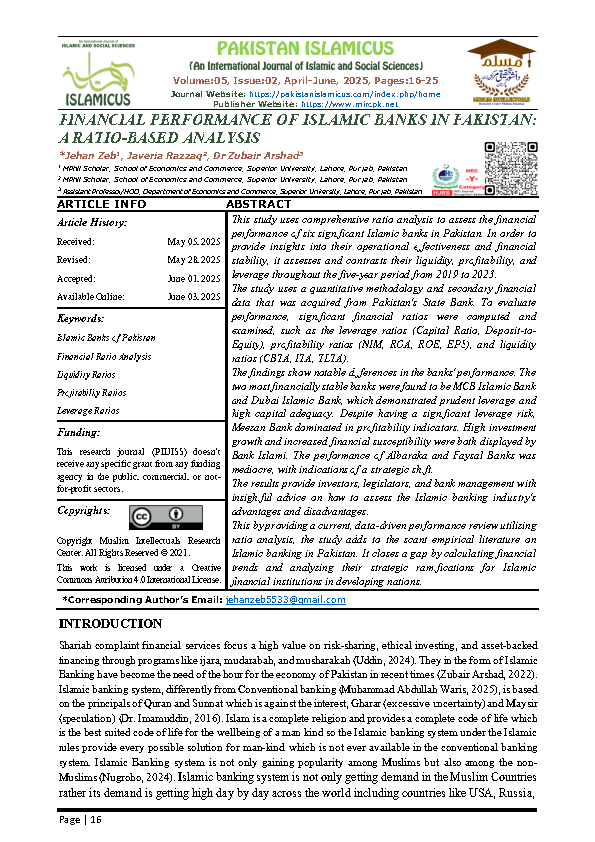FINANCIAL PERFORMANCE OF ISLAMIC BANKS IN PAKISTAN: A RATIO-BASED ANALYSIS
Keywords:
Islamic Banks of Pakistan, Financial Ratio Analysis, Liquidity Ratios, Profitability Ratios, Leverage Ratios.Abstract
This study uses comprehensive ratio analysis to assess the financial performance of six significant Islamic banks in Pakistan. In order to provide insights into their operational effectiveness and financial stability, it assesses and contrasts their liquidity, profitability, and leverage throughout the five-year period from 2019 to 2023.
The study uses a quantitative methodology and secondary financial data that was acquired from Pakistan's State Bank. To evaluate performance, significant financial ratios were computed and examined, such as the leverage ratios (Capital Ratio, Deposit-to-Equity), profitability ratios (NIM, ROA, ROE, EPS), and liquidity ratios (CBTA, ITA, TLTA).
The findings show notable differences in the banks' performance. The two most financially stable banks were found to be MCB Islamic Bank and Dubai Islamic Bank, which demonstrated prudent leverage and high capital adequacy. Despite having a significant leverage risk, Meezan Bank dominated in profitability indicators. High investment growth and increased financial susceptibility were both displayed by Bank Islami. The performance of Albaraka and Faysal Banks was mediocre, with indications of a strategic shift.
The results provide investors, legislators, and bank management with insightful advice on how to assess the Islamic banking industry's advantages and disadvantages.
This by providing a current, data-driven performance review utilizing ratio analysis, the study adds to the scant empirical literature on Islamic banking in Pakistan. It closes a gap by calculating financial trends and analyzing their strategic ramifications for Islamic financial institutions in developing nations.
References
A Estrella, S. P. (2000). Capital ratios as predictors of bank failure. Economic policy review- ssrn.
Ahmad, S. Z. (2021). Reputation and cost benefits forattitude and adoption intentionamong potential customers usingtheory of planned behavior: anempirical evidence from Pakistan. Emerald Insight.
Albaity, M. (2019). The intention to use Islamic banking: an exploratory study to measure Islamic financial literacy. Emerald Insight.
Arabiat, H. A. (2024). The intention to adopt metaverse. Emerald Insigh, 24.
Asma Salman, Huma Nawaz, M. Hassan Bukhar. (2018). GROWTH ANALYSIS OF ISLAMIC BANKING IN PAKISTAN: A QUALITATIVE APPROACH. Academy of Accounting and Financial Studies Journal.
Asma Salman, Huma Nawaz, M. Hassan Bukhari. (2018). GROWTH ANALYSIS OF ISLAMIC BANKING IN PAKISTAN: A QUALITATIVE APPROACH. Academy of Accounting and Financial Studies Journal, 8.
Chappra. (2022). The Future of Economics: An Islamic Persepective. Middle East Quarterly Fall.
Chong and Liu. (2009). Islamic banking: interest-free or interest-based? Pacific-Basin Finance journal.
Dr. Imamuddin, D. A. (2016). Principles of Islamic Economics in the Light of the Holy Quran and Sunnah. International Journal of Humanitis and Social Science.
Dr. Imamuddin, Dr. Ahmed Saeed. (2016). Principles of Islamic Economics in the Light of the Holy Quran and Sunnah. International Journal of Humanitis and Social Science.
El-Bdour, E. a. (2019). Attitudes, behaviour, and patronage factors of bank customers towards.
Ernayani, R., Sari, O., & Robiyanto. (2017). The Effect of Return on Investment, Cash Ratio, and Debt to Total Assets Towards Dividend Payout Ratio (A Study Towards Manufacturing Companies Listed in Indonesia Stock Exchange). Advance science letters.
Fahmy and Yusof. (2008). Are Islamic banks in Malaysia really Islamic? Munich Personal RePEc Archive, 13.
Faruq, W. A. (2023). Financial Stability Analysis of Islamic Banks of Bangladesh. European Journal of Business and Management Research .
Haroon, N. M. (2021). Validity of zakat ratios as Islamic performance indicators in Islamic banking: a congeneric modeland conformatory factor analysis. Emerald Insight.
Haroon, R. A. (2011). Factors Influencing Products’ Knowledge of Islamic Banking Employees. Journal of Islamic Studies and Culture.
Hassanain Haykal Et Al. (2024). BUILDING SHARIA LAW BANKING SYSTEM IN GLOBAL ECONOMIC DEVELOPMENT UNDER LOCAL WISDOM BASIS. RGSA.
Imran, Naveed and Ahmad. (2017). Determinants of low adoption of islamic banking in pakistan. Journal of Islamic Marketing, 33.
Jaffar and Musa. (2016). Determinants of attitude and intention towards Islamic financing adoption among non-users. Procedia Economics and Finance.
Jamal Rafia, N. E. (2024). Ṣukūk al-Muḍārabah as a Financing and Liquidity Management Tool for Islamic Banks in Morocco: Exploratory Analysis of Expectations and Obstacles. ISRA International Journal of Islamic Finance.
Khadija Abrar, S. R. (2024). Evaluating the impact of Big Data on Financial Reporting Quality in Pakistan’s Banking Sector. Evaluating the impact of Big Data on Financial Reporting Quality in Pakistan’s Banking Sector.
Khattak. (2019). Customer satisfaction and awareness of Islamic banking system in Pakistan. African Journal of Business Management.
Khoso, A. A. (2021). The Role of Islamic Banking Industry in The Perspective of Global Financial Sector and its Impact in Pakistan's Economic Growth. International Research Journal of Education and Innovation.
Kumar, D. P. (2017). IMPACT OF EARNING PER SHARE AND PRICE EARNINGS RATIO ON MARKET PRICE OF SHARE: A STUDY ON AUTO SECTOR IN INDIA. International Journal of Research - GRANTHAALAYAH.
Kurnia, R. (2024). EVALUATION OF PERFORMANCE OF ISLAMIC BANKS IN INDONESIA:COMPARATIVE ANALYSIS USING FINANCIAL RATIOS. Jurnil Tamwil.
Kurniawan, A. (2021). ANALYSIS OF THE EFFECT OF RETURN ON ASSET, DEBT TO EQUITY RATIO, AND TOTAL ASSET TURNOVER ON SHARE RETURN. JIEMAR.
Lawati, L. (2021). The Effect of Loan to Deposit Ratio and Debt to Equity Ratio on Return on Equity. Jurnal Manajemen Dan Bisnis.
Lucky Nugroho, T. M. (2022). of Islamic Performance Ratio in Islamic Banks with Return on Asset as Moderating factor. International Journal of Commerce and Finance.
M. Abdullah Idress Et Al. (2024). Comparative analysis of FinTech adoption among Islamic and conventional banking users with moderating effect of education level: A UTAUT2 perspective. Journal of Open Innovation: Technology, Market, and Complexity.
Majeed, Zainab. (2016). Efficiency analysis of Islamic banks in Pakistan. Humanomics.
Mariyanti, L. N. (2021). Discourses of Islamic Performance Ratio Based on Tawhid String Relationship. JIESS.
Mariyantri, L. N. (2021). Discourses of Islamic Performance Ratio Based on Tawhid String Relationship. JIESS.
Maryam, M. K. (2019). “Factors influencing the community behavioral intention for adoption of Islamic banking. International Journal of Islamic and Middle Eastern Finance and Management.
Muhammad Abdullah Waris, Z. A. (2025). Evaluation of Customer Satisfaction and Economic Efficiency: A Study of Conventional and Islamic Insurance Industry in Pakistan. Pakistan Journal of Humainities and Social Science, 13.
Nugroho, A. P. (2024). Comparative Analysis of the Efficiency of Islamic and Conventional Banking Systems: A literature review. Journal of Economics, Business and Accounting.
Omar Al Farooque, R. O. (2023). Does intellectual capital in Islamic banks outperform conventional banks? Evidence from GCC countries. Emerald logo.
Parasuraman, A. Z. (2020). Servqual: A multiple-item scale for. Journal of retailing.
Pitchy AB, T. M. (2019). Factors persuade individuals' behavioral intention to opt for Islamic bank services Malaysian depositors' perspective. Web of Science.
PUSPITASARI, S. H. (2021). Net Interest Margin and Return on Assets: A Case Study in Indonesia. The Journal of Asian Finance, Economics and Business.
Rahmat, H. F. (2024). EVALUATION OF PERFORMANCE OF ISLAMIC BANKS IN INDONESIA: COMPARATIVE ANALYSIS USING FINANCIAL RATIOS. ResearchGate, 16.
Rashid, C. A. (2021). HE EFFICIENCY OF FINANCIAL RATIOS ANALYSIS TO EVALUATE COMPANY’S PROFITABILITY . Journal of Global Economics and Business.
SBP. (2019). Islamic banking bulletin: State Bank of Pakistan. SBP.
SBP. (2025). Financial Statement Analysis. Retrieved 2025, from State Bank of Pakistan: https://www.sbp.org.pk/reports/annual/FSAFS/2023-Annual/index.htm
Siti Sarah, K. D. (2023). The Effect of Total Assets Turnover, Debt to Assets Ratio, Cash Ratio and Current Ratio on Financial Performance of Companies The Hotel, Restaurant and Tourism Subsector in IDX for The Period 2016-2020. Jurnal Syntax Admiration.
Subaien, R., & Villis, L. (2010). A SYSTEM OF ANALYSIS OF THE TOTAL LIABILITIES TO TOTAL ASSETS RATIO. Ekonomika.
Sutrimi, S. (2024). Financial ratio analysis of financial distress in Indonesia stock exchange-listed customer goods corporations . eJournal Sean Institute.
Tara, N. I. (2014). Factors influencing adoption of Islamic Banking in Pakistan. Journal of Public Administration and Governance.
Tura, G. (2024). DETERMINANTS OF BRAND SELECTION IN THE BANKING INDUSTRY: FACTORS AFFECTING BRAND SELECTION. Vol. 1 No. 1 (2024): Premium Thesis Repository .
Twaha Kigongo Kaawaase, J. B. (2019). Determinants of the intention to adopt Islamic banking in a non-Islamic developing country. Emerald Insight.
Uddin, S. (2024). Legal Foundations for Shariah-Compliant Islamic Banking in Pakistan: Challenges and the Way Forward. SSRN, 18.
Usmani. (2012). An Introduction to Islamic Finance. Quranic Studies Publishers karachi Pakistan.
Utami, W. B. (2017). ANALYSIS OF CURRENT RATIO CHANGES EFFECT, ASSET RATIO DEBT, TOTAL ASSET TURNOVER, RETURN ON ASSET, AND PRICE EARNING RATIO IN PREDICTINGGROWTH INCOME BY CONSIDERING CORPORATE SIZE IN THE COMPANY JOINED IN LQ45 INDEX YEAR 2013 -2016. IJEBAR.
WangXuhui, S. A. (2019). Determinants of intention to use Islamic banking. Emerald Insight.
Wita Sri Nurlatipha, F. r. (2022). Analysis of Financial Ratios on The Performance of Muamalat Indonesia bank. MJIFM.
Yusoff, M. E. (2017). Muslims Consumers Attitudes Towards Islamic Finance . Jurnal Kemanusiaan.
Zainab, M. t. (2017). How Islamic is Islamic banking. Emerald Insight, 15.
Zeenat maryam, Ashfaq, nauman, Sadia. (2021). Reputation and cost benefits forattitude and adoption intentionamong potential customers usingtheory of planned behavior: anempirical evidence from Pakistan. Emerald Insight.
Zeenat, Ashfaq, nauman, Sadia. (2021). Reputation and cost benefits forattitude and adoption intentionamong potential customers usingtheory of planned behavior: anempirical evidence from Pakistan. Emerald Insight.
Zeshan. (2016). CUSTOMER PREFERENCES IN SELECTION OF ISLAMIC AND CONVENTIONAL BANKING IN PAKISTAN. Global Journal of Management and Social Sciences ISSN.
Zubair Arshad, T. H. (2022). How does Corporate and Shariah governance Influence the Default Risk: A Mediating Role of Risk Committee. International Journal of Management Research and Emerging Sciences.

Downloads
Published
Issue
Section
License
Copyright (c) 2025 PAKISTAN ISLAMICUS (An International Journal of Islamic & Social Sciences)

This work is licensed under a Creative Commons Attribution 4.0 International License.
This work is licensed under a Creative Commons Attribution 4.0 International License.

































